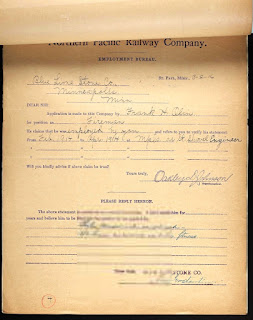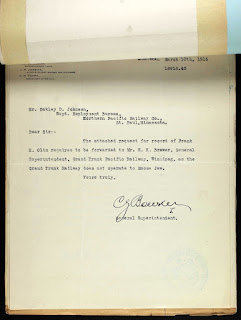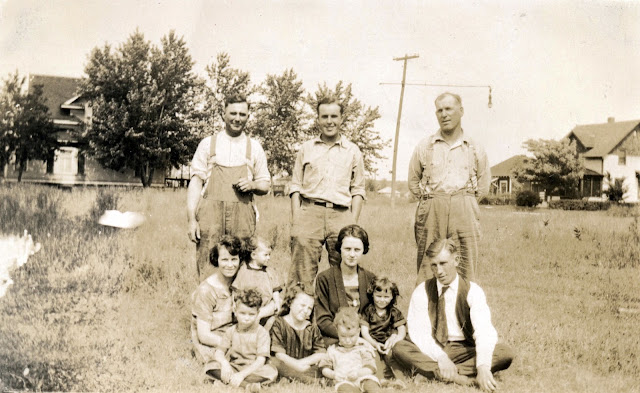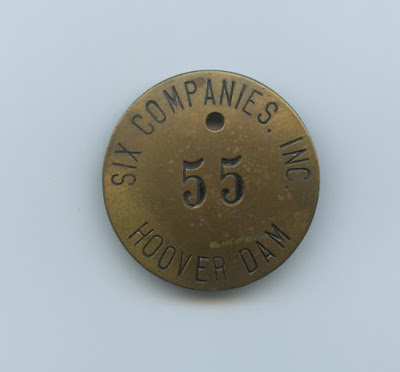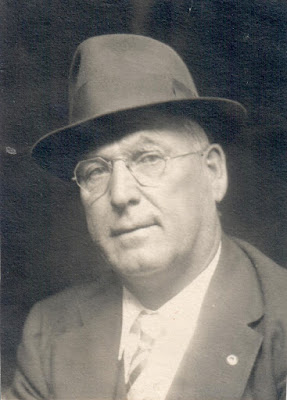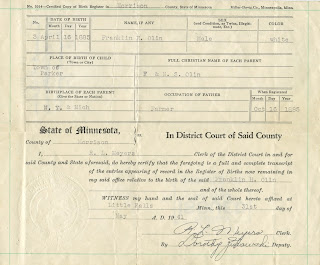Frank Olin - Early Life
Frank's father, Thomas Benjamin Olin, was born in New York state (Chemung County) in 1844. At the age of fifteen, in 1860, just prior to the start of the American Civil War, Tom's extended family loaded buck-board wagons and moved out to Mecosta City, in north-central Michigan, where they found a tract of land and established a farm. It was while working at the farm that Tom met Mary Cunningham, the adopted daughter of Frank Cunningham. Both of her parents died when she was three years old, leaving her and her two sisters in foster care. Mary's early life was difficult. Born in Ceresco, Michigan ... (or possibly Vermont) with a cleft-palate, she was treated cruelly at the foster home, and she eventually ran away at the age of eight to live with one of her two older sisters. When Tom and Mary were 22 and 17 years old, respectively, they married in Greenville, Michigan (August 11, 1866).
Four of Frank's older siblings, Willard, Emily, Florance, and Otis were born in Michigan. Brother Florance died of one of the multitude of diseases that took so many young children, at the age of two (and is buried at Mecosta Cemetery). Partly to assuage their sadness, the Olin family boarded a train and headed west on the Great Northern Railroad. They arrived at Fridley Station, fifteen miles north of Minneapolis, in November 1879.
Thomas acquired forty acres of land in Fridley that had possibly been part of a Civil War (or Mexican War) land grant. He had hoped to start a farm there. But after staying for three weeks, they determined that the soil was too sandy and moved northwest to Dayton (1880 census data and older brother Willard's school records confirm this). However, the ground was not fertile-enough for farming at that location either, and the family again moved north, homesteading in Morrison County, near Little Falls in 1881. The homestead documentation reads: Southeast 1/4 Section of 2 Parker Township, Morrison Cty. Eldest son Willard owned a section adjacent to that of Thomas and Mary.
Sister Sarah (1880) was born in Dayton, while brother Henry (1883) ... and Franklin Herbert Olin, the youngest child of Thomas and Mary Olin (April 16, 1885), were born at the Morrison homestead.
 |
Henry, Sarah (Sadie), and Frank
In 1892, when Frank was seven years old, the family moved north to Staples, Minnesota, where Tom ran a boarding house. In 1894 (or 1896), the family moved still further north to Grand Rapids, Minnesota. This trip was arduous, particularly for old Tom, who was carried via ox cart from Aitken to Grand Rapids, after breaking his leg along the way.
 |
| The Thomas and Mary Olin Family (1883 Staples, Minnesota) Top: Willard, Emma Center: Sadie, Mary, Thomas Bottom: Frank, Lottie (Emma's daughter), and Henry |
Frank, now eleven years old, helped his father establish and build the Floto Hotel and Amusement Park, located on Swan Lake, twelve miles northeast of Grand Rapids, near Pengilly. One of the landmarks, a ferris wheel that Tom built, was handed-down for generations. For months, the family lived in tents while they built the park and their home in Bovey.
 |
| Thomas and Mary under canvas at Swan Lake (Pengilly, Minnesota) |
 |
| Mary Olin, Will Sandretzky, Lola Sandretzky Foels (in wheelbarrow), Tom Olin, Sadie Olin Sandretzky, and Effren Sandretzky at Swan Lake Resort |
Franklin Olin became a local legend for being the first person ever to take a load of lumber eight miles, from Grand Rapids to Bovey, Minnesota.
 |
| Frank, with Uncle Kingston, hauling lumber (Bovey, Minnesota) |
To survive the cold winters, Tom and his sons ice-fished and marketed toboggan-loads of their catch, often taking it to Coleraine for sale. Frank developed a passion for fishing that endured for the rest of his life.
Another passion was music. Frank played drum in the local marching band, along with father Tom. One of the drums he played remains in the hands of the Olin family
(Thomas F. Olin, Jr.) today ...
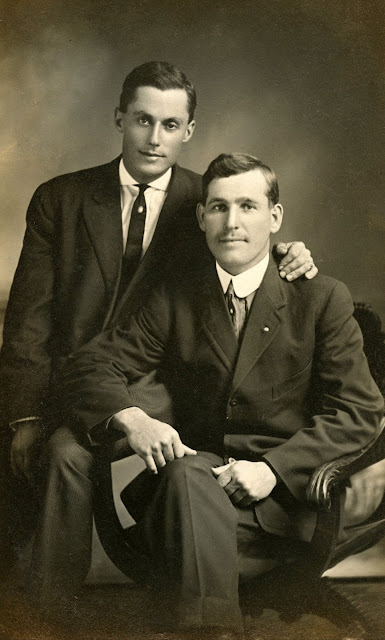 |
| Brothers Henry and Frank Olin (Circa 1902) |
Hard-luck and difficult times seemed ever-present. Brother Henry was killed when a tree fell on him at the Morrison homestead. Eldest sister Emily developed polio. Old Tom broke his leg again, while traversing Pokegama Lake near Grand Rapids ... and years later, he was run over by a team of horses and taken to Mayo Clinic, but refused treatment. He spent the last few years of his life in a rocking chair.
Being the youngest of seven children, Frank was very laid-back and easy-going, like his father. He was well-liked within the family and enjoyed making friendships with virtually everyone he met. He was a very handsome young man ... and a hit with the ladies.
 |
| Olin Family Portrait: Thomas B. Olin, Emma, Frank, Sadie, Mary, and Willard |
On November 20, 1902, seventeen-year-old Frank married the lovely nineteen-year-old Sophrona C. Leifermann from Blue Earth, Minnesota. Her nickname was 'Veronica'. They initially lived in Bovey, near his parents, then moved to Iron Range. Less than a year later (September 29, 1903) Veronica gave birth to their only child, son Merton Franklin Olin.
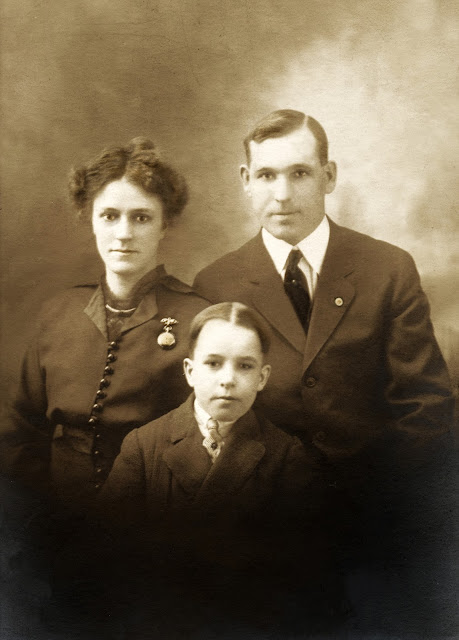 |
| Veronica, Merton, and Frank Olin |
Frank worked a number of odd jobs to make ends meet. He performed basic construction and carpentry ... and tried plastering once (at least according to relative Rena Olin). Frank's first plaster job was to do a residential ceiling. A carpenter had lathed the ceiling and Frank came in behind him to plaster over it. He did a beautiful job. However, just as the owner was coming up the walk to inspect the work, the entire wet ceiling collapsed. Frank grabbed his tools and ran out the back door!
Digging A Ditch ... The Panama Canal
At the turn of the century, an industrial revolution was underway in northern Minnesota, and Frank quickly learned that he was uniquely skilled in maintaining and operating heavy equipment. It is very likely that Frank developed some of these skills while working on the farm, and later the amusement park, with his Dad. Frank discovered that he was particularly skilled with large-scale steam engines, such as those used with locomotives as well as the huge steam shovels cleaving ore from the Mesabi Range, only a few miles northeast of Bovey, in Hibbing. He was a natural, and became one of the elite few who could operate the massive equipment.
 |
| Frank (left) as steam locomotive engineer for Oliver Iron Mining Company. |
Times were tough for a small family just starting out, but a huge opportunity was ready to present itself to Franklin Olin. On May 6, 1904, President Theodore Roosevelt appointed John Findley Wallace, formerly chief engineer and finally general manager of the Illinois Central Railroad, as chief engineer of the Panama Canal Project, after the failed endeavor had been abandoned by the French. Overwhelmed by the disease-plagued country and forced to use often dilapidated French infrastructure and equipment, as well as being frustrated by the overly bureaucratic ICC, Wallace resigned abruptly in June 1905. He was succeeded by John Frank Stevens, a self-educated engineer who had built the Great Northern Railroad.
The entire canal was re-designed from the original French plans, adding locks and increasing capacity. The construction of a canal with locks required the excavation of more than an additional 170,000,000 cubic yards of material over and above the 30,000,000 cubic yards excavated by the French. Old, unusable French equipment was immediately replaced with modern American construction equipment that was designed for a much larger and faster scale of work. More than a hundred new railroad-mounted steam shovels were purchased and brought in from the United States. These were joined by enormous steam-powered cranes, giant hydraulic rock crushers, cement mixers, dredges, and pneumatic power drills, nearly all of which was manufactured with new, extensive machine-building technology developed in the ore mines of Minnesota.
 |
| Photos of Frank Olin operating a steam shovel at the Panama Canal (1908) |
Between 1905 and 1908, Frank was part of a Minnesota steam shovel crew that repeatedly traveled to Panama to maintain and operate the massive excavation equipment. Even though it meant being away from his young family, the canal project provided a few good years of experience and steady work.
Home On The Range
Upon his return from Panama, Franklin sought employment where he could ... at the Mesabi Range, where iron ore was in high demand. In fact, demand was so high for ore that the Hibbing High School was torn down in order to access the mineral below it.
In 1908, Frank operated one of 170 steam shovels that were in operation in the Mesabi range at the time.
 Frank Olin, steam shovel operator at the Mesabi Iron Range (top right) |
Frank's line of work stipulated that employment would be contractual, terminating upon the completion of individual 'jobs', sometimes lasting a year or less. Thus, Frank's employment as a steam shovel/locomotive engineer was a vagabond existence. His fascinating employment history is found in Northern Pacific Railway Company records publicly available at the Minnesota Historical Society, St. Paul, Minnesota:
February 1908 - March 1912 Oliver Mining Company
Coleraine, Minnesota
(Fireman)
March 1912 - February 1913 Oliver Mining Company
Coleraine, Minnesota
(Steam Shovel Engineer)
January 1913 - February 1914 Grand Trunk Pacific Railway
Moose Jaw, Saskatchewan
(Fireman)
February 1914 - April 1914 Blue Limestone Company
Minneapolis, Minnesota
(Steam Shovel Engineer)
April 1914 - May 1915 Butler Brothers
Hibbing, Minnesota
(Steam Shovel Engineer)
February 1916 - February 1917 Northern Pacific Railway Company
Duluth, Minnesota
(Fireman)
1917 - 1921 Unknown
1922 -1925 Scranton Mine
Hibbing, Minnesota
(Engineer-Foreman)
March 1925 - June 1926 Winston-Dear Company
Hibbing, Minnesota
(Steam Shovel Engineer)
In the fascinating collection of correspondence seen below, Frank applies for a job as engineer with the Northern Pacific Railway Company and earns employment for 1916 through 1917. We also learn that Frank lost the end of his big toe on his right foot somewhere along the way:
Public records also show that Frank moved incessantly throughout Minnesota ...
1915 - Virginia (13 Nasau Loc)
1916 - Minneapolis (2nd Avenue & 3rd Street - Hotel Summit)
1916 - Minneapolis (2nd Avenue & 3rd Street - Hotel Summit)
1916 - Duluth (29 N 23rd Avenue W)
1917 - Virginia (416 McKinley)
1922 - Virginia (W S 12th Avenue S of Mesaba)
1928 - Minneapolis (2618 Emerson Avenue N - Radisson Hotel)
For most of those years, however, Frank lived in Virginia (just north-east of Hibbing), Minnesota. By 1913, despite being destroyed by fire twice (in 1893 and 1900), the city of Virginia was the fourth richest in Minnesota.
Similarly, the population of Hibbing exploded between 1900 and 1930, from 2,400 people to nearly 16,000 as iron ore provided the raw material for the industrial revolution in America at that time.
 |
| All in a day's work for Frank (top left) |
Indeed, Hibbing had become a minor boom-town back in those days and Frank enjoyed every minute of it. Despite the fact that he was a non-drinker, he was well known in the area as a "Good-time Charlie", was an exceptional dancer (despite his truncated toe), and was almost always in good humor. Wherever he went, wherever he lived ... everybody who ever knew Frank liked him.
These were among the best of times for Frank. But then again, any time was among the best of times for Frank.
 | ||||||
| Frank (left) at the Scranton Mine, Hibbing, Minnesota (1923)
By the mid-1920s, Frank's son Merton had moved out, married Ann Sylvia Roring (a beautiful young lady from Minneapolis), and had begun working for Capper & Capper Men's Clothing Store at 2518 Emerson Avenue North, downtown Minneapolis, in the lobby of the Radisson Hotel.
(1928) In 1928, Frank and Veronica became grandparents when Merton and his wife Ann celebrated the birth of their son, Thomas F. Olin. Sadly, Frank's wife, Veronica, became ill shortly thereafter, passing away in 1930 in Mapleton.
Veronica Olin - Find-A-Grave Digging A Dam ... Hoover Dam On January 10, 1931, a consortium of six construction companies named "Six Companies, Inc." made the winning bid on a massive dam project near Las Vegas, Nevada. Almost immediately, more than 20,000 unemployed men descended upon the site, looking for work. This was not the case for Frank Olin. He was hand-picked by Six Companies to operate the large-scale excavation and construction equipment required to complete the job.
Frank's "Six Companies" Identification Badge was number 55 ... out of 5,521 issued.
Frank worked continuously on the Boulder (Hoover) Dam project for four years, completing it in 1935. Heavy-equipment operators were provided better facilities than the manual laborers, but not much better. They were also paid a higher wage. Laborer bunkhouses were spread throughout the hillsides surrounding the project among the squatter's camps (with names such as McKeeversville and Williamsville).
During the project, 112 workers perished during construction, 42 of which likely died of carbon monoxide poisoning due to heavy-equipment exhaust trapped in the tunnels.
Home On The Range - Part II Upon completion of the dam, Frank returned to Minnesota, and once again, looked for employment. He worked for Consolidated Materials Company (Cutler Magner Company) between 1936 and 1940 and also contracted as a shovel and dragline operator for Minneapolis-based Walter W. Magee Company in 1936 and 1942.
He had always been a ladies man, and now finding himself single once again, he enjoyed socializing and establishing friendships with several local women for companionship. He also continued to spend much of his free time fishing, and visiting with his grand-children. Grandson Tom recalled a Christmas when Frank gave him and his younger brother Jim each a dart gun at Christmas. Frank lay on the floor with a target on his head!
He remained active in the community, and gained its respect ... being selected as an Honored Guest at the 1941 Grand Rapids Golden Jubilee.
Left: Mert and Frank, Right: Frank
(Photos circa 1940)
But according to the 1940 census, however, Frank had left the mines, and was working as a traveling salesman in Minneapolis. He had established a relationship with Victoria A. Hagman, a friendly Swedish lady, eighteen years his junior. Victoria, or 'Vicky' as she was known to her friends and family, was born in 1902 and emigrated from Sweden, arriving at Ellis Island on December 20, 1920. Her maiden name at that time was Angelina Viktoria Danielsson. She was born on September 14, 1902, in Asarum, Blekinge, Sweden. (Sweden Birth Records, U.S. Naturalization Index, Port of New York Passenger Lists):
The arrival of Angelina Viktoria Danielsson
(Victoria A. Hagman) in the United States She married Andrew Hagman in 1923. They were divorced some time between 1930 and 1940. There are no public records that she officially married Frank, but by the 1940 census, Frank and Vicky were listed as man and wife and living at 401 Essex Avenue, Minnetonka:
1940 Census
|
Digging For Our Defense ... The U.K. of Great Britain Project
1944 ... the world was at war. Frank was working for Medical Arts Building Company, 1200 Roanoke Building. Vicky worked at Sears, Roebuck and Company, 2929 Elliot Avenue South:
On the other side of the globe, military plans were being made for a continental invasion of Europe from Great Britain. There was an emergency need for heavy-equipment operators to travel overseas to assist in building military infrastructure; such as runways, naval ports, and fuel-drilling operations. At 58 years of age, Frank enlisted as a SeaBee and volunteered for a confidential assignment entitled "The UK of Great Britain Project".
Frank needed to submit personal information and a number of references to W.E. Callahan Construction Company for security purposes: (click to enlarge)
Frank's birth certificate was stamped by the United States Department of State, he was issued a passport, and instructed to proceed to New York City, where he would board a British Airways Flying Boat to an undisclosed location:
Frank eventually made his way to the west coast of England, near Manchester and Liverpool, where he worked on several excavation projects through the end of the war:
A New Life For Franklin Olin
 |
| Frank and Vicky after the war |
Frank returned to Minneapolis after his wartime assignment and to his love, Vicky. She was a perfect match for him; friendly, good-tempered, and loved by his entire family.
 |
| Frank, Vicky, and her mother (circa 1950) |
By 1953, Frank had qualified for a monthly social security benefit of $65.70. Even though he had been long-since retired, Frank maintained a Steam Engineer's License - First Class through 1955.
 |
| Frank and Vicky (Late 1950s) |
Franklin Herbert Olin died of a heart attack on May 28, 1959 (73 years of age), in Brainerd, Minnesota and is buried in Itasca Calvary Cemetery, Grand Rapids, Minnesota. He was survived by his son and his wife, Merton and Vicky, who both lived until 1981.
 |
| Franklin Olin Family Record (Found in Franklin's family Bible) |
Sources:
Ruth Ellis Franklin Herbert Olin Family Website
Thomas and Gloria Olin
Lee (Olin) Stepanchak
Rena Olin
Ancestry.com
U.S. Census Bureau Data
Minnesota Historical Society
U.S. City Directories (1822 - 1995)
Sweden Birth Records
U.S. Naturalization Service Records
Port Of New York Passenger Lists
The Olin Family Trilogy:


















